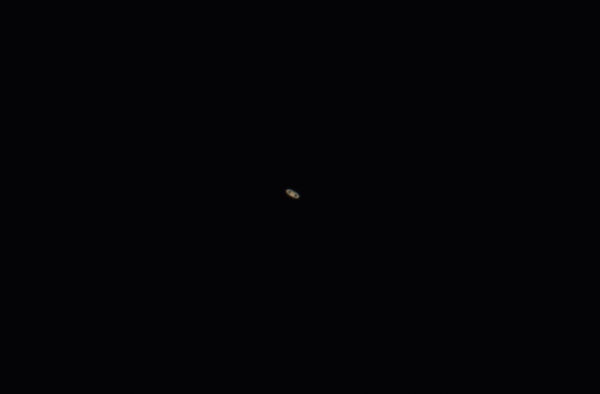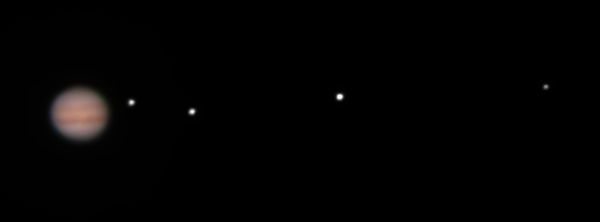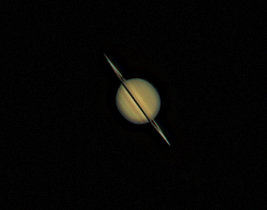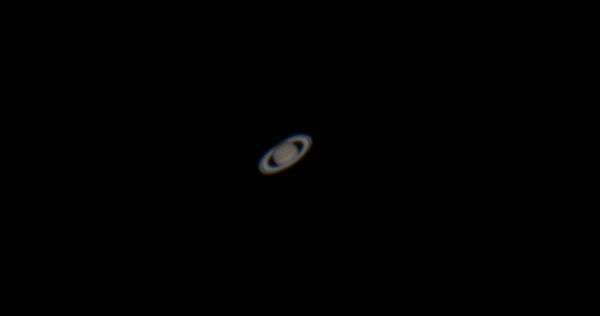Saturn this morning
Jul 14, 2019 12:40:17 #
Jul 14, 2019 13:01:56 #
Ballard wrote:
Here is a shot of Saturn I took this morning. This is a stack of ~900 frames taken from a 4K video using an 11 inch Schmitt Cassegrain and a canon 5D markIV in 4K video mode. The stacking software was the freeware program "RegiStax6".
Very nice!
I shot 10,000 frames of video with a 1400mm scope and QHY 183C camera a couple of nights ago and didn't get anywhere near as good an image. Planetary imaging is a challenge!
bwa
Jul 14, 2019 13:16:23 #
Jul 14, 2019 13:57:33 #
Jul 14, 2019 13:58:02 #
Jul 14, 2019 14:18:22 #
Jul 14, 2019 16:24:41 #
Ballard
Loc: Grass Valley, California
Wallen wrote:
Initially i was hoping to see some of them because you mentioned it was a an 11" reflector as a 6” used under decent skies can show objects down to magnitude 13.5. That would be able to show Mimas, Enceladus & Thethys which are closer to the planet that Titan, specially if they are about to transit.
Then i realize if Saturn is still low in the horizon, atmospheric distortions could have made them impossible to view.
The Jupiter images were beautiful.
Then i realize if Saturn is still low in the horizon, atmospheric distortions could have made them impossible to view.
The Jupiter images were beautiful.
Hi Wallen
You are correct looking through the scope you can make out several of the moons however the image taken with the camera doesn't record much if any signal of these dim moons at 1/30th second exposure. The main reason you can visual see them is that the human eye has a tremendous dynamic range ~14 F stops (this is particularly true in dim light) while the best sensors top out around 11. This is the main reason you don't see any moons in the photo. The sensors do have the advantage that they can stay open for a long period and gather more light to see very dim objects but this would blowout the image of Saturn. The ones that would have been in the field of view of the photo at the time of the picture was taken would have been Rhea (Magnitude 9.8), Mimas (Magnitude 13.0), Tethys (Magnitude 10.3), Enceladus (Magnitude 11.8) and Dione (Magnitude 10.20), Iapetus (magnitude 11.2) would probably just been outside the field of view . Titan (magnitude 8.4 and Hyperion (Magnitude 14.3) were definitely out of the field of view of the photo.
Jul 14, 2019 17:04:01 #
Ballard
Loc: Grass Valley, California
bwana wrote:
Very nice!
I shot 10,000 frames of video with a 1400mm scope and QHY 183C camera a couple of nights ago and didn't get anywhere near as good an image. Planetary imaging is a challenge!
bwa
I shot 10,000 frames of video with a 1400mm scope and QHY 183C camera a couple of nights ago and didn't get anywhere near as good an image. Planetary imaging is a challenge!
bwa
Hi Bwana
For this image I took a 4K video Mov file and then converted the frames to Jpeg (For Deep sky time exposures I normally convert RAW to 16bit TIFF files to maintain the full range, but I don't have enough memory to stack a 1000 frames of TIFF, I am planning on upgrading my 10 year system soon however). In any case to give you an idea of the image scale and what an individual frames looked like I've included 1 of the several 1000 jpegs I was using. Note: I also waited until 12:35AM until just before Saturn was transiting so it was as high as it was going to get above the horizon. Compared to the final image you can really see the benefit of stacking many images to improve the signal to noise of the image.
Jul 14, 2019 17:36:49 #
Ballard wrote:
Hi Bwana br For this image I took a 4K video Mov f... (show quote)
My best single frame (out of 10,000) attached (1400mm FL scope).
I owned a C11 at one time but found it too much focal length for the atmospherics on the eastern slopes of the Rockies. My sweet spot for imaging is 1000-1400mm and I normally stay away from planetary imaging
 .
.On a REALLY good night I might get something like the 2nd attachment; 1000mm FL w/ mono camera and filters.
bwa
Saturn-Best Single Frame 2019-07-12 w/ Bresser MC-100, QHY 183C (50%ofFullSize)

(Download)
Jupiter & Moons_LRGB(Best10of1000frames) w/ S-W 190 Mak, QHY 163M (FullSize)

(Download)
Jul 14, 2019 21:26:25 #
Ballard
Loc: Grass Valley, California
The moons of Jupiter come out much brighter than I get with the DSLR, perhaps that is because of the separate luminance image? In any case I think the larger image size I get with the C11 helps the planet images. For Deep sky If just started using a canon F 4.0 500mm lens piggyback on my refractor as a guide scope. This has started working well (see https://www.uglyhedgehog.com/t-598763-1.html, https://www.uglyhedgehog.com/t-599872-1.html and the best one so far https://www.uglyhedgehog.com/t-600370-1.html)
Jul 14, 2019 23:12:42 #
Jul 14, 2019 23:29:20 #
Ballard wrote:
...In any case I think the larger image size I get with the C11 helps the planet images. ...
I was once told by a long time planetary imager that anything less than 4000mm FL was useless for planets. I have to sorta agree with him.

My best Saturn was shot with a C8 EdgeHD w/ 2x PowerMate (4000mm) and a QHY 8 Pro CCD, per below. 2010 is about the last time I've had atmospheric conditions conducive to planetary imaging.

bwa
Saturn-2010May10

Jul 15, 2019 12:40:16 #
Ballard
Loc: Grass Valley, California
I used a barlow lens on the C11 when I took the shots of Saturn and Jupiter so I was around 5000mm. Nice shot of Saturn, it really shows the bulge due to its spin, currently the angle of the rings hide one pole making the bulge less apparent.
Jul 15, 2019 13:20:49 #
Ballard wrote:
I used a barlow lens on the C11 when I took the shots of Saturn and Jupiter so I was around 5000mm. Nice shot of Saturn, it really shows the bulge due to its spin, currently the angle of the rings hide one pole making the bulge less apparent.
The current orientation is much nicer!
bwa
Jul 15, 2019 15:05:28 #
If you want to reply, then register here. Registration is free and your account is created instantly, so you can post right away.





